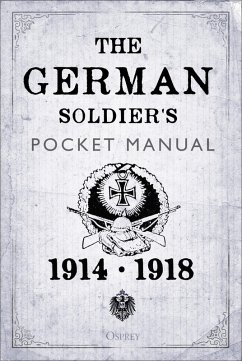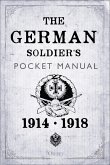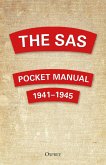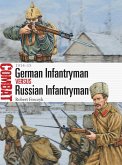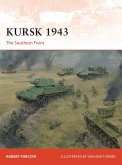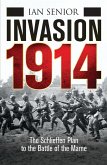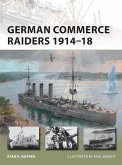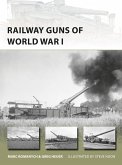6,99 €
6,99 €
inkl. MwSt.
Sofort per Download lieferbar

3 °P sammeln
6,99 €
Als Download kaufen

6,99 €
inkl. MwSt.
Sofort per Download lieferbar

3 °P sammeln
Jetzt verschenken
Alle Infos zum eBook verschenken
6,99 €
inkl. MwSt.
Sofort per Download lieferbar
Alle Infos zum eBook verschenken

3 °P sammeln
- Format: PDF
- Merkliste
- Auf die Merkliste
- Bewerten Bewerten
- Teilen
- Produkt teilen
- Produkterinnerung
- Produkterinnerung

Bitte loggen Sie sich zunächst in Ihr Kundenkonto ein oder registrieren Sie sich bei
bücher.de, um das eBook-Abo tolino select nutzen zu können.
Hier können Sie sich einloggen
Hier können Sie sich einloggen
Sie sind bereits eingeloggt. Klicken Sie auf 2. tolino select Abo, um fortzufahren.

Bitte loggen Sie sich zunächst in Ihr Kundenkonto ein oder registrieren Sie sich bei bücher.de, um das eBook-Abo tolino select nutzen zu können.
This is the first Pocket Manual to be dedicated to the German Army in the First World War, with chapters comprising of complete documents or extracts drawn from two major sources: the German Army of 1914 - 1918 itself, or the intelligence sections of other armies.
It describes the new tactics and units developed by the German army during the war, including the myths surrounding Stormtrooper units. These new methods used were a result of interaction between the opposing forces and incremental in their appearance.
Nevertheless the new ideas were hugely influential and important not…mehr
- Geräte: PC
- mit Kopierschutz
- eBook Hilfe
- Größe: 10.96MB
Andere Kunden interessierten sich auch für
![The German Soldier's Pocket Manual (eBook, ePUB) The German Soldier's Pocket Manual (eBook, ePUB)]() Stephen BullThe German Soldier's Pocket Manual (eBook, ePUB)6,99 €
Stephen BullThe German Soldier's Pocket Manual (eBook, ePUB)6,99 €![The SAS Pocket Manual (eBook, PDF) The SAS Pocket Manual (eBook, PDF)]() Christopher WesthorpThe SAS Pocket Manual (eBook, PDF)6,99 €
Christopher WesthorpThe SAS Pocket Manual (eBook, PDF)6,99 €![German Infantryman vs Russian Infantryman (eBook, PDF) German Infantryman vs Russian Infantryman (eBook, PDF)]() Robert ForczykGerman Infantryman vs Russian Infantryman (eBook, PDF)12,95 €
Robert ForczykGerman Infantryman vs Russian Infantryman (eBook, PDF)12,95 €![Kursk 1943 (eBook, PDF) Kursk 1943 (eBook, PDF)]() Robert ForczykKursk 1943 (eBook, PDF)12,95 €
Robert ForczykKursk 1943 (eBook, PDF)12,95 €![Invasion 1914 (eBook, PDF) Invasion 1914 (eBook, PDF)]() Ian SeniorInvasion 1914 (eBook, PDF)6,99 €
Ian SeniorInvasion 1914 (eBook, PDF)6,99 €![German Commerce Raiders 1914-18 (eBook, PDF) German Commerce Raiders 1914-18 (eBook, PDF)]() Ryan K. NoppenGerman Commerce Raiders 1914-18 (eBook, PDF)9,95 €
Ryan K. NoppenGerman Commerce Raiders 1914-18 (eBook, PDF)9,95 €![Railway Guns of World War I (eBook, PDF) Railway Guns of World War I (eBook, PDF)]() Marc RomanychRailway Guns of World War I (eBook, PDF)9,95 €
Marc RomanychRailway Guns of World War I (eBook, PDF)9,95 €-
-
-
This is the first Pocket Manual to be dedicated to the German Army in the First World War, with chapters comprising of complete documents or extracts drawn from two major sources: the German Army of 1914 - 1918 itself, or the intelligence sections of other armies.
It describes the new tactics and units developed by the German army during the war, including the myths surrounding Stormtrooper units. These new methods used were a result of interaction between the opposing forces and incremental in their appearance.
Nevertheless the new ideas were hugely influential and important not only to the German army but to others as well, including British and American forces.
Utilising a wide range of sources, including various pamphlets and manuals that were produced throughout World War I, this fascinating pocket manual gives a German perspective to World War I.
It describes the new tactics and units developed by the German army during the war, including the myths surrounding Stormtrooper units. These new methods used were a result of interaction between the opposing forces and incremental in their appearance.
Nevertheless the new ideas were hugely influential and important not only to the German army but to others as well, including British and American forces.
Utilising a wide range of sources, including various pamphlets and manuals that were produced throughout World War I, this fascinating pocket manual gives a German perspective to World War I.
Produktdetails
- Produktdetails
- Verlag: Bloomsbury UK eBooks
- Seitenzahl: 144
- Erscheinungstermin: 28. Juni 2018
- Englisch
- ISBN-13: 9781472831071
- Artikelnr.: 55001526
- Verlag: Bloomsbury UK eBooks
- Seitenzahl: 144
- Erscheinungstermin: 28. Juni 2018
- Englisch
- ISBN-13: 9781472831071
- Artikelnr.: 55001526
- Herstellerkennzeichnung Die Herstellerinformationen sind derzeit nicht verfügbar.
Dr Stephen Bull worked for the National Army Museum and BBC in London before taking up his current post as Curator of Military History and Archaeology with Lancashire Museums. A consultant to the University of Oxford he is also a Member of the Institute for Archaeologists, and has made TV appearances that include the series Battlefield Detectives, news and archaeology features. Published on both sides of the Atlantic and in several languages, he is the author of a number of works for Osprey including titles on tactics in World War II. Dr Bull has been one of the key contributors to the accompanying television series screened in the United Kingdom and North America.
1) Der Spatenkrieg: a translation of the January 1915 manual by Heinrich
Fitschen: 'Sweat saves blood'. Shows the new importance of the spade in
trench warfare and how things have changed since open warfare in August
1914. A privately produced piece but based on official instructions.
(Approximately 35 pages with existing 'in text' illustrations and a brief
one page introductory note.) 2) Der Dienst im Schützengraben: translation
of undated instructions for service in the trenches at company level giving
the duties of different ranks. Privately produced by Lieutenant der Reserve
Wilhelm Botz of Reserve infantry Regiment number 74. (Approximately 48
pages including a one page introductory note and three new illustrations.)
3) Proposals for Technical Methods: an early 1915 document translated by
British intelligence showing new thought in response to French attacks on
the Germans in the Champagne. (approximately 10 pages including a one page
introductory note and two new illustrations) 4) Flammenwerfer: German
Instructions for the Employment of Flame Projectors translation of
instructions from December 1915 showing how the infantry coordinate with
the flame attack. (approximately 10 pages including one page introductory
note and a new illustration) 5) Orders and Reports on the German Raid on
the 'Spion', La Boisselle: Extracts from German documents of April 1916
describing a trench raid by 110th Reserve Infantry Regiment. (approximately
15 pages to include a two page introductory note and two new illustrations)
6) Regulations for Machine Gun Officers, 1916: Approximately 8 pages
including a one page intro and one illustration. 7) Nahkampfmittel: Part 3
of the Manual of position warfare 1917. Grenades and close combat methods.
British translation including diagrams. (approximately 10 pages including
one page intro and two new pictures ) 8) Anleitung fur Kompagniefuhrer
1917: selection from a German official document giving a standard training
regime for an infantry company. 9) German Company attack diagram:
Passchendaele 1917. From a captured document in Canadian War diaries. ( 3
pages: double page rendition of the diagram and a one page intro. 10) The
Attack In Position Warfare: the Stormtrooper instruction of January 1918
showing integration of all arms and objectives, January 1918.
(Approximately 35 pages including on page introductory note and four new
illustrations
Fitschen: 'Sweat saves blood'. Shows the new importance of the spade in
trench warfare and how things have changed since open warfare in August
1914. A privately produced piece but based on official instructions.
(Approximately 35 pages with existing 'in text' illustrations and a brief
one page introductory note.) 2) Der Dienst im Schützengraben: translation
of undated instructions for service in the trenches at company level giving
the duties of different ranks. Privately produced by Lieutenant der Reserve
Wilhelm Botz of Reserve infantry Regiment number 74. (Approximately 48
pages including a one page introductory note and three new illustrations.)
3) Proposals for Technical Methods: an early 1915 document translated by
British intelligence showing new thought in response to French attacks on
the Germans in the Champagne. (approximately 10 pages including a one page
introductory note and two new illustrations) 4) Flammenwerfer: German
Instructions for the Employment of Flame Projectors translation of
instructions from December 1915 showing how the infantry coordinate with
the flame attack. (approximately 10 pages including one page introductory
note and a new illustration) 5) Orders and Reports on the German Raid on
the 'Spion', La Boisselle: Extracts from German documents of April 1916
describing a trench raid by 110th Reserve Infantry Regiment. (approximately
15 pages to include a two page introductory note and two new illustrations)
6) Regulations for Machine Gun Officers, 1916: Approximately 8 pages
including a one page intro and one illustration. 7) Nahkampfmittel: Part 3
of the Manual of position warfare 1917. Grenades and close combat methods.
British translation including diagrams. (approximately 10 pages including
one page intro and two new pictures ) 8) Anleitung fur Kompagniefuhrer
1917: selection from a German official document giving a standard training
regime for an infantry company. 9) German Company attack diagram:
Passchendaele 1917. From a captured document in Canadian War diaries. ( 3
pages: double page rendition of the diagram and a one page intro. 10) The
Attack In Position Warfare: the Stormtrooper instruction of January 1918
showing integration of all arms and objectives, January 1918.
(Approximately 35 pages including on page introductory note and four new
illustrations
1) Der Spatenkrieg: a translation of the January 1915 manual by Heinrich
Fitschen: 'Sweat saves blood'. Shows the new importance of the spade in
trench warfare and how things have changed since open warfare in August
1914. A privately produced piece but based on official instructions.
(Approximately 35 pages with existing 'in text' illustrations and a brief
one page introductory note.) 2) Der Dienst im Schützengraben: translation
of undated instructions for service in the trenches at company level giving
the duties of different ranks. Privately produced by Lieutenant der Reserve
Wilhelm Botz of Reserve infantry Regiment number 74. (Approximately 48
pages including a one page introductory note and three new illustrations.)
3) Proposals for Technical Methods: an early 1915 document translated by
British intelligence showing new thought in response to French attacks on
the Germans in the Champagne. (approximately 10 pages including a one page
introductory note and two new illustrations) 4) Flammenwerfer: German
Instructions for the Employment of Flame Projectors translation of
instructions from December 1915 showing how the infantry coordinate with
the flame attack. (approximately 10 pages including one page introductory
note and a new illustration) 5) Orders and Reports on the German Raid on
the 'Spion', La Boisselle: Extracts from German documents of April 1916
describing a trench raid by 110th Reserve Infantry Regiment. (approximately
15 pages to include a two page introductory note and two new illustrations)
6) Regulations for Machine Gun Officers, 1916: Approximately 8 pages
including a one page intro and one illustration. 7) Nahkampfmittel: Part 3
of the Manual of position warfare 1917. Grenades and close combat methods.
British translation including diagrams. (approximately 10 pages including
one page intro and two new pictures ) 8) Anleitung fur Kompagniefuhrer
1917: selection from a German official document giving a standard training
regime for an infantry company. 9) German Company attack diagram:
Passchendaele 1917. From a captured document in Canadian War diaries. ( 3
pages: double page rendition of the diagram and a one page intro. 10) The
Attack In Position Warfare: the Stormtrooper instruction of January 1918
showing integration of all arms and objectives, January 1918.
(Approximately 35 pages including on page introductory note and four new
illustrations
Fitschen: 'Sweat saves blood'. Shows the new importance of the spade in
trench warfare and how things have changed since open warfare in August
1914. A privately produced piece but based on official instructions.
(Approximately 35 pages with existing 'in text' illustrations and a brief
one page introductory note.) 2) Der Dienst im Schützengraben: translation
of undated instructions for service in the trenches at company level giving
the duties of different ranks. Privately produced by Lieutenant der Reserve
Wilhelm Botz of Reserve infantry Regiment number 74. (Approximately 48
pages including a one page introductory note and three new illustrations.)
3) Proposals for Technical Methods: an early 1915 document translated by
British intelligence showing new thought in response to French attacks on
the Germans in the Champagne. (approximately 10 pages including a one page
introductory note and two new illustrations) 4) Flammenwerfer: German
Instructions for the Employment of Flame Projectors translation of
instructions from December 1915 showing how the infantry coordinate with
the flame attack. (approximately 10 pages including one page introductory
note and a new illustration) 5) Orders and Reports on the German Raid on
the 'Spion', La Boisselle: Extracts from German documents of April 1916
describing a trench raid by 110th Reserve Infantry Regiment. (approximately
15 pages to include a two page introductory note and two new illustrations)
6) Regulations for Machine Gun Officers, 1916: Approximately 8 pages
including a one page intro and one illustration. 7) Nahkampfmittel: Part 3
of the Manual of position warfare 1917. Grenades and close combat methods.
British translation including diagrams. (approximately 10 pages including
one page intro and two new pictures ) 8) Anleitung fur Kompagniefuhrer
1917: selection from a German official document giving a standard training
regime for an infantry company. 9) German Company attack diagram:
Passchendaele 1917. From a captured document in Canadian War diaries. ( 3
pages: double page rendition of the diagram and a one page intro. 10) The
Attack In Position Warfare: the Stormtrooper instruction of January 1918
showing integration of all arms and objectives, January 1918.
(Approximately 35 pages including on page introductory note and four new
illustrations
